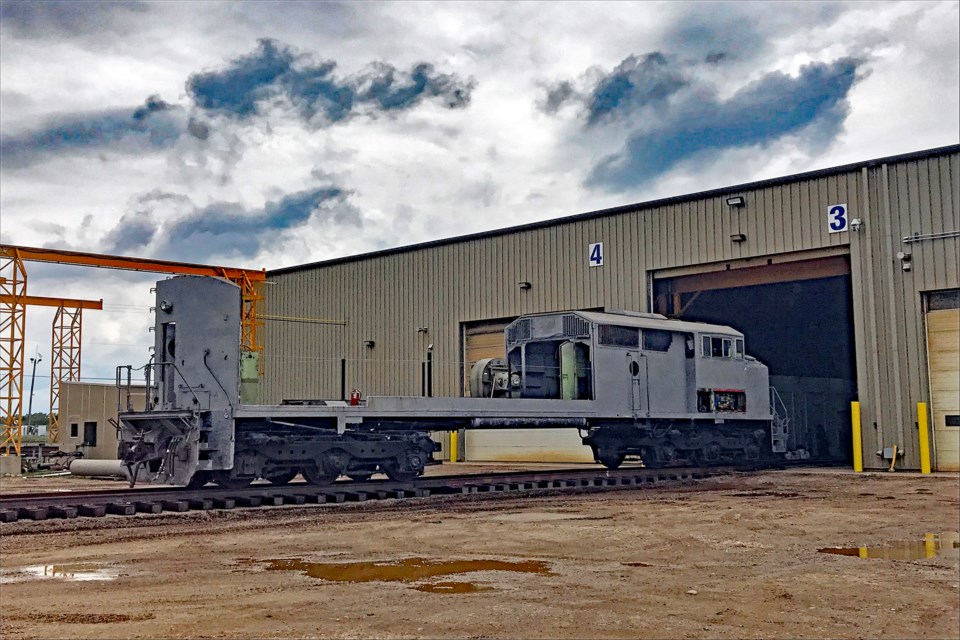INNISFAIL – With the recent momentous announcement of a partnership with Canadian Pacific that aims to create clean running locomotives for the entire continent, its another stepping stone on a long mission for Innisfail businessman Robert Bilton to make the world a much greener and better place.
There’s an urgency to his mission, which is firmly grounded on fact and science, that the merits of securing a healthier world now for his family, Innisfail and beyond is beyond debate.
“I think everyone nowadays has a very clear understanding that we are in transition from hydrocarbons that caused greenhouse gases. If we're not, we're living in the past,” said Bilton, the CEO and president of Bilton Welding and Manufacturing Ltd. “By reforming natural gas, or with electrolysis, we can make hydrogen that's very green, and then at point of use there is no greenhouse gases produced at all.”
Through a collaboration with Canadian Pacific, his company is on the threshold of super-powering the fortunes of the rail industry in a way not seen since the full conversion to electric and diesel power in the late 1930s.
The two companies have been working together under Canadian Pacific’s Hydrogen Locomotive Program, which has a goal of playing a leading role in decarbonizing the freight transportation sector, to successfully convert a diesel locomotive to a hydrogen-electric drivetrain with zero carbon emissions.
In recent years hydrogen power has rapidly grabbed increased attention nationally and internationally as a viable alternative fuel option as there is no vehicle emissions other than water vapour. Its fuel economy is considered equivalent to about twice that of gasoline vehicles.
“One of the issues with gasoline and diesel is that to be able to make that perfectly clean in your vehicle is completely impossible, whereas we can build plants that can make hydrogen and take any of the greenhouse gases that are produced in that process and sequester them in carbon capture,” said Bilton. “And that way we can truly clean up our environment.”
Bilton’s road to play a critically important part of Canadian Pacific’s Hydrogen Locomotive Program began as far back in 2008 when he met and talked several times to senior provincial government officials that was then led by the now dissolved Progressive Conservative Party of Alberta.
Bilton said he wanted to know when a plan was going to be rolled out to prepare Alberta for the new technologies that were to going to come out to face the inevitable energy transition.
“I was met with sort of blank stares,” recalled Bilton. “These what we call leaders seemed to be stuck in the past, you know; ‘if you can make good money off oil, why would you do anything else?"
“That was a big frustration for me,” he added. “As time went on, I started to take the perspective, ‘Well, if you want something done, I guess you better do it yourself.'”
A decade later Bilton was a key player in getting the $24 million Innisfail Solar Farm off the ground, and then another in Drumheller.
“These were green projects that were doable, and I started there. I then I started looking at other things,” said Bilton.
One of those things was Canadian Pacific’s keen interest in hydrogen power.
The rail company announced in late 2020 its plan to design and build North America’s first line-haul hydrogen-powered locomotive that would rely on cells and batteries to power the locomotive's electric traction motors.
“We were happy to partner with someone like CP on this type of work,” said Bilton. “And when we got the chance, we said, ‘sure, we know it's going to be hard. We know there's a lot of learning but we're willing to do it.
“And we started that process.”
The initial process for the CP/Bilton project began almost three years ago at Bilton’s manufacturing facilities in Innisfail.
“It started with meetings with CP finding someone that would work with them on this project. CP has worked with us constantly throughout that period,” said Bilton.
“We're weekly in meetings with their engineers, their design people, and they're working with our engineers and our design people,” he said. “This is an engine with a diesel motor in it. We want to convert it. What do we have to do?
“We just started working through one issue after another one and we're now just starting on the third engine,” added Bilton. “We're streamlining processes and making improvements based on the data that's been found by reading the early models.”
Bilton said it took about a year and a half to get the first new hydrogen-powered engine completed. This was due to the COVID-19 pandemic and to troublesome supply chain issues.
“Our intention is to get this down to a process where we can do 10 a year, and then 50 a year, and then continue to develop that process,” said Bilton. “In North America there's literally tens of thousands of engines that are now running on diesel. So there's a huge number of engines, that if this becomes a practical cost-effective solution, could be converted.”
And if the call came that mass production of the new hydrogen-powered engines was viable and necessary, Bilton said he would be elated, not only for his company but for the Town of Innisfail.
“That would be the greatest dream for both myself and my company, and I think the community,” said Bilton, who expressed gratitude to the Town of Innisfail for its support of the project, which included the approval of a rail spur into his company’s southwest Innisfail plant.
“It would bring a great amount of work to Innisfail but also good work for talented skilled people," he said.



